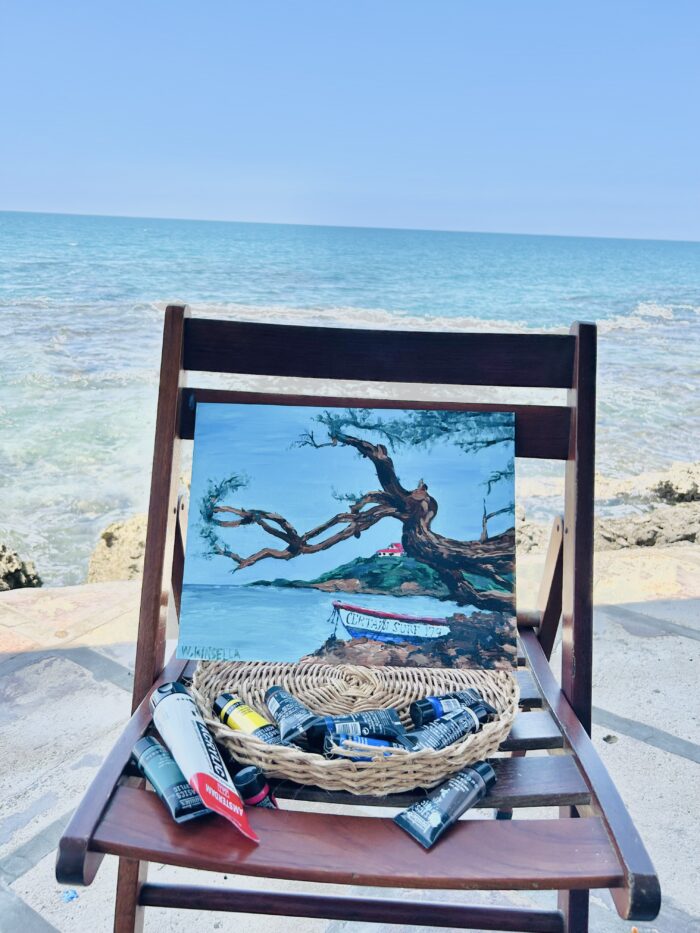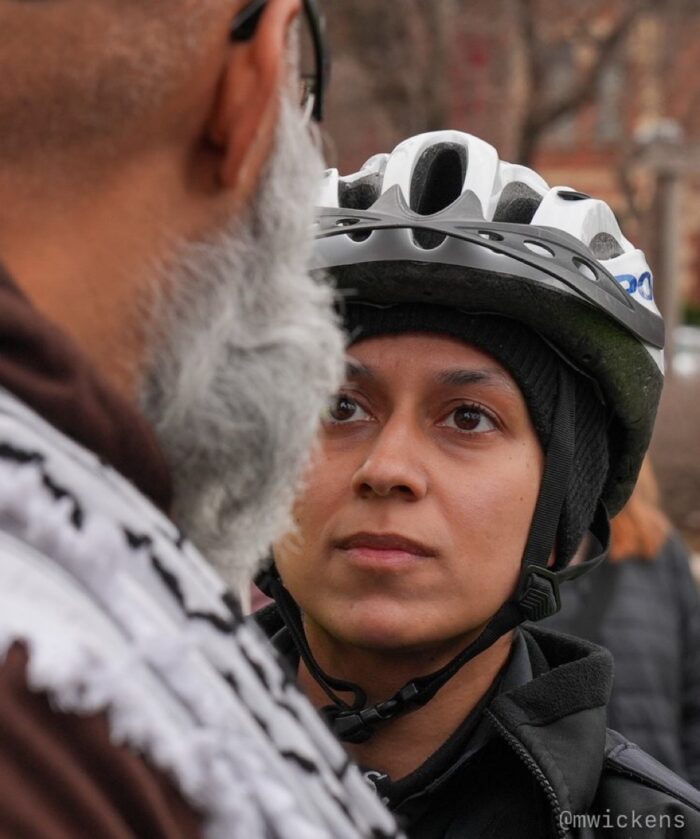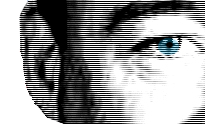My latest: is this obstruction of justice?
Politicians can’t direct police. They can’t direct prosecutors.
But can they do indirectly what they can’t do directly?
They shouldn’t. And, in the case of two politicians who are members of the Toronto Police Services Board, they can try.
And they did.
In recent days, Toronto police have been attacked, physically, by the pro-Hamas mobs. Even though cops in Canada’s largest city have shown extreme restraint – sometimes to the point that some of us have been highly critical of them – they have still been attacked by those who hate the Jewish state.
Video evidence shows they’ve been speared with signs. They’ve been physically assaulted. And they’ve even had horse feces thrown at them.
Some of those crimes have resulted in arrests. Some are still the subject of active investigations.
And that doesn’t even include the other ongoing police investigations – the unsolved firebombing of a Jewish delicatessen, anti-Semitic vandalism and threats, and more.
So, with all of those criminal investigations still under way – with Toronto police themselves the actual victims of crimes – should elected members of the police board be issuing a letter to side with the haters, and against the police?
The answer is obvious. No. Never.
In their Code of Conduct, Toronto police board members are required to act impartially, and never, ever interfere with police work. But two far-Left members of the board – Amber Morley and Lily Cheng – have seemingly done just that.
On Thursday night, Morley and Cheng issued an extraordinary statement along with four other Leftist city councillors. In it, they stated that those who protest against Israel and the Jewish community – in recent days, even by targeting synagogues for hate – “must be protected.”
In the middle of criminal investigations of attacks on Jews and the police, Cheng and Morley and the others said – in boldface print, no less – that what most of us regard as the Israel-hating mob must “be free to demonstrate and engage in protest.”
Nobody disputes anybody’s right to protest. That’s a constitutional right.
But should two Leftist city councillors – two councillors who have enormous power, setting the police service’s budget and its policies – make such a statement in the middle of ongoing criminal investigations?
No way. Never.
Their Code of Conduct forbids it, in multiple sections. It looks like they are interfering with police operations (section 2). That they are speaking on behalf of the board, when they shouldn’t (section 5). That they should not pick sides and should always act impartially (section 7).
That they should inspire public confidence – all of the public, not just some extremist members of the public (section 8). And on and on.
These two city councillors aren’t just warming seats. They have enormous power – one of which is picking the Chief of Police.
For them to issue that statement in the middle of ongoing police investigations is so, so wrong. It’d be like a judge offering an opinion about a defendant in the middle of a trial – before a decision has been reached. It’s just not done.
And, here, it is breaking the rules in a serious way.
Morley and Cheng need to resign from the Toronto Police Services Board.
And if they won’t resign, they should be fired.
Treasure Beach, Jamaica, en plein air.

Sun Media panel: is CBC fair to Israel?
April 4, MLK
Since I was a kid – since this day in 1972, in fact, when I started writing a daily journal – I have always taken note of April 4, and said to myself: “April 4. Dr. King.”
Today, more than half a Century ago, Martin Luther King was murdered by a racist in Memphis. Dr. King was a giant of a man, the one whose message continues to resonate across the decades, because racial hatred continues unabated.
He was the one who first said that “anti-Zionism” was, in fact, just plain old anti-Semitism. Worth remembering in these dark post-October 7 days.
I was a kid, and my family was living in Dallas when he was assassinated. I remember it; I remember how scared we were when he was murdered, how it seemed like the end of decency, and the start of something terrible. It was, too.
So. It’s April 4, so many years later, and here is some of his most remarkable speech. Surveying the racists who still crowd the public stage in the U.S., I don’t think we will see the likes of him again.
My latest: CBC, where fairness towards Israel goes to die
Canada’s state-funded national broadcaster has a secretive committee to oversee the network’s reporting on Israel – presumably to provide balance.
But Jews who work at the CBC say the network’s coverage isn’t balanced. At all.
Said one: “It’s depressing, I am afraid to speak up because I hear stories about my colleagues getting reprimanded. I feel like I am bashing my head against the wall.”
Another: “Jewish journalists aren’t being listened to. When ideas are being pitched it falls on deaf ears. [Our] stories are being ignored.”
Now, the suggestion that Canada’s state-funded broadcaster has been less-than-fair to Israel, before and after the horrors of October 7, isn’t particularly news. CBC refuses to describe the terrorist group Hamas as terrorists; it routinely accepts unverified casualty counts that come from Hamas; and, to cite just one example, it has refused – unlike other major media organizations – to apologize for falsely accusing Israel of bombing a hospital in Gaza City and killing hundreds.
For most Jews, CBC’s ongoing coverage of Israel can be fairly described by the Honest Reporting watchdog: “CBC News provides one-sided smears of Israel.”
The notion that the Canadian Broadcasting Corporation tilts against Israel isn’t news, as noted. But the revelation that there exists a covert internal group overseeing CBC’s coverage of Israel, and that stories that are critical of the anti-Israel side are being actively suppressed? That’s news.
Consider these appalling facts from Jews who work within CBC:
• CBC News Network has not put The IDF on the air since before 2024
• One anchor has been posting very anti-Israel posts on social media – behind a wall, so only a select few can see it
• There’s no tracking of CBC coverage on perspectives – nor who is being put on the air
Said one former senior CBC producer – who, like all the others, feared retribution for speaking out: “As a former CBC person, I am deeply disappointed and troubled by the coverage of this war. It’s extremely one-sided and is only leading to more misinformation and hatred towards the Jewish community in Canada.
“The CBC was once the gold standard for journalism. However, those days are now gone – unless something radically changes within management.”
Asked for a comment about the shadowy “committee’s” work, CBC spokesperson Kerry Kelly admitted that it exists, which has not been publicly revealed before. Said Kelly: “We have a longstanding Middle East advisory committee created a few years ago to give CBC leadership recommendations about long-term coverage strategy in the region.”
When October 7 happened – when 1,200 men, women, children and babies were slaughtered, and 200 more taken hostage – CBC ramped up the work of the clandestine group. Said Kelly: “When coverage intensified in October, we put together a list of internal contacts (producers with extensive international experience) to provide editorial support if needed. Reporters and producers can choose to email them to ask questions or seek advice on day-to-day coverage of the Israel-Hamas war.”
Insisted Kelly: “They don’t review coverage.”
But how can the committee “provide advice” if they’re not in fact reviewing CBC coverage? And, for that matter, who is on the committee? What is their expertise? And what about suggestions that Jewish voices are disregarded, or non-existent on the committee?
Says Kelly: “We don’t have access to individual statistics on our staff’s religious or cultural identity, nor is that information we would share.”
She then goes to share what she says CBC management don’t have access to: “I can confirm the assertion that no one on the list belongs to the Jewish faith, or identifies as Jewish, is false on both accounts.”
Make sense to you? Me neither.
And nor does their coverage – which is, indeed, wildly unfair to those millions of viewers and listeners who support Israel and desperately want a balanced perspective. Will the taxpayer-funded ever get around to supplying that kind of balance?
Don’t hold your breath.
My latest: the Lawfare warriors
Who are you going to call?
It’s not a Ghostbusters reference – although, the mission is similar: to defeat evil.
If you’re Jewish – or if you’re a supporter of Israel and the Jewish community – and you’re being harassed or attacked or vilified or threatened? Then you should call the Lawfare Project.
The Lawfare Project is based in New York City, but is led by a brilliant Canadian woman from Toronto. It’s a team of more than 600 lawyers based in different countries, and created in 2010 to protect the civil and human rights of Jews everywhere. It’s a pro bono effort – meaning, literally, “for the public good,” and at no cost, too. Lawyers donate their time to fight for Jews facing anti-Semitism and hate.
And they’re very busy, these days.
Western democracies are presently in the midst of the worst surge in anti-Semitism since the Holocaust. October 7 was the worst of it, of course, with 1,200 men, women, children and babies tortured and slaughtered in Israel by Hamas – and 200 taken hostage in Gaza, where more than 100 remain.
But since that terrible day, Jews around the globe have been targeted for the supposed sins of the Israeli government. And, for some, “it’s become perfectly acceptable to project their hatred of a foreign government on Jews,” says Brooke Goldstein, the founder and executive director of the Lawfare Project.
Born and raised in Toronto, Goldstein went to McGill University in Montreal, then the Benjamin Cardozo School of Law in New York City. She’s an extraordinary person, and is the granddaughter of a commander of a unit of Polish partisans who fought the Nazis in World War Two. And she started the Lawfare Project after working as a film producer and an advocate for children’s rights.
The Lawfare Project essentially got its start with her 2011 book, Lawfare: The War Against Free Speech: A First Amendment Guide for Reporting in an Age of Islamist Lawfare. In it, Goldstein offers advice to journalists about how to protect themselves from Islamic extremists who increasingly use the law as a weapon to silence, or punish, those who dare to write about militant Islamists, terrorism – and their funding sources. (Full disclosure: this writer has been targeted by multiple legal actions by opponents of the Jewish state.)
“We fight those who use the legal system as a weapon of war,” says Goldstein from New York, where she is based. “You see this happening with Israel, right now – the bias, the horrific charges of genocide and apartheid, and so on. It’s the attempt to add a legal patina to a blood libel against Jews, and abuse the international legal system, to hinder the ability of Israel and other democracies to fight and defeat terrorism.”
That fight expresses itself in myriad ways, Goldstein, says. At any given time, the Lawfare Project promotes civil rights by providing legal help to those who have been discriminated against. It advocates for human rights by combatting extremism. And, most off all, it fights “lawfare” – the abuse of legal institutions to destabilize democracy everywhere. Not just Israel.
One of Goldstein’s partners is the affable senior counsel Gerard Filitti, who was also on the line from New York. Told about this newspaper’s efforts to document how anti-Israel protesters and organizers are getting paid to show up – and how the money for that is often coming from outlaw states like Qatar and Iran – Filitti isn’t surprised.
Says he: “We currently have a lawsuit against Carnegie Mellon University [in Pittsburgh], which over the years have received more than $800 million (U.S.) from Qatar – and it is also a university where we have seen a dramatic increase in anti-Semitism on campus during that time period. We want to see if there is a connection between the anti-Semitism and the funding.”
In that case, the Lawfare Project is representing a Jewish student. And, they stress, they want to hear from Jewish students in Canada – and Jewish non-students – who are being demonized for supporting the just and proper war on Hamas. Or for just being Jewish.
“We are trying to see what this money is doing…because we are seeing so much money coming in, from Qatar especially.”
They are doing God’s work at the Lawfare Project – for Jews and Jewish allies alike.
Got a human rights issue? Give them a call. They might be able to help.
[Kinsella is a lawyer who is establishing a war room to combat the rise in anti-Semitism in Canada.]
Fearless
Toronto Police officer facing down the Jew-hating Hamas mob. I love this photo, and how utterly fearless she looks.

Some news about me
This isn’t how I wanted this to come out. But someone (we think we know who) has leaked it, and it was going to come out anyway. So, yes: I’m putting out my farewell column later today, and then heading back to Ottawa, where I will again be toiling for #LPC. Interesting times.
Liars who lie
The other side has used the word “genocide” so many times, against so many, so inaptly, that it has completely lost all meaning.
Like most propaganda, their propaganda will only persuade the propagandists in the end. It long ago became facile bullshit to everyone else.

